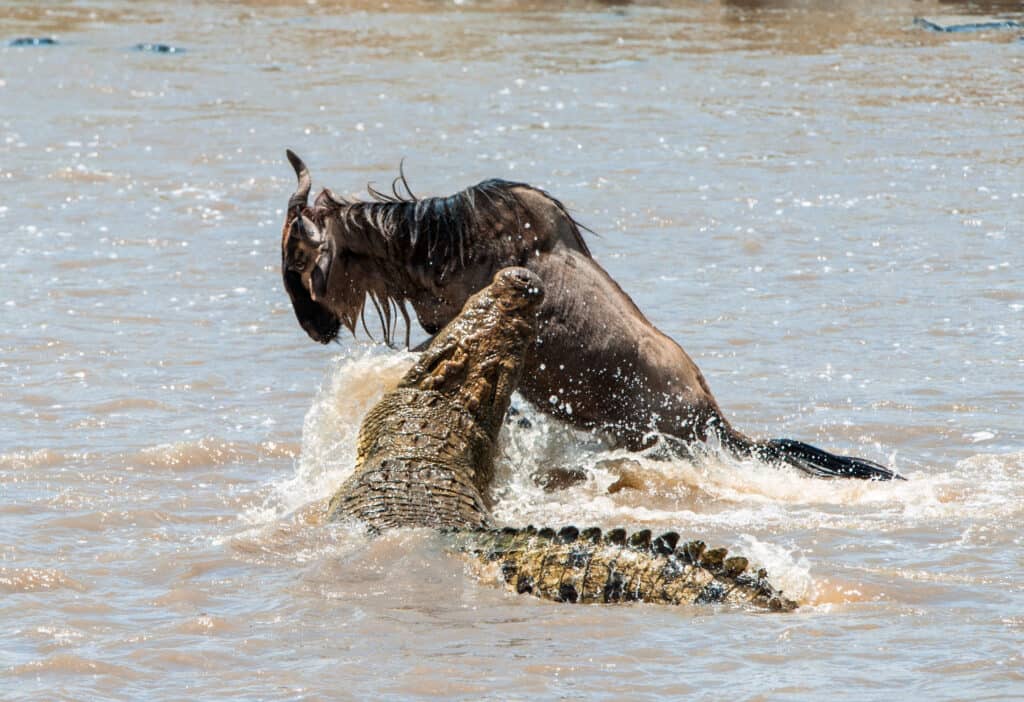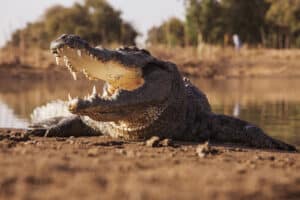Although most people are aware that crocodiles and alligators are dangerous, it’s not often we have to really be worried about them. Sure, if we plan on swimming in a pond in Florida we should be careful, but that isn’t really something that most people do on a regular basis. Thankfully, crocs and gators are relegated to their swampy realm, a place that humans rarely tread. Well… that wasn’t always true, historically. In fact, one ancient crocodile didn’t just leave the water to hunt, it was adapted to gallop at its prey as fast as a horse! Let’s discover the massive crocodile that could gallop like a horse (it’s the stuff of nightmares)!
The Crocodile That Could Gallop Like A Horse

An
ancient crocodile
that lived 100 million years ago was able to gallop like a horse.
©David Havel/Shutterstock.com
In the past few decades, scientists have unearthed a lot of fossils. Aside from the dinosaurs, however, most of them could have easily lived alongside humans without too much issue. That is until they unearthed Kaprosuchus saharicus and Laganosuchus thaumastos. Both of these species were found in the Sahara Desert at a dig site and may be the scariest crocodiles to have ever been found.
What makes these crocs so scary? Their ability to run! Modern crocodiles and alligators are evolved to spend their days in the water, lounging about until unsuspecting prey wanders too close to the shoreline. Although they can run when needed, it isn’t something they like to do. K. saharicus and L. thaumastos, on the other hand, are perfectly adapted for running.
After measurements of the fossils were taken, scientists estimated that both species of croc (which were found right next to each other) were around 20 feet tall, had large tusks, and had long legs that were ideal for galloping sprints.
“My African crocs appeared to have had both upright, agile legs for bounding overland and a versatile tail for paddling in water,” writes Paul Sereno, a palaeontologist at the University of Chicago, in National Geographic Magazine. “These species open a window on a croc world completely foreign to what was living on northern continents.”
The Guardian
When And Where Did These Sprinting Crocodiles Live?

and
L. thaumastoswere both found in modern-day Morocco and Niger, somewhere in the Sahara Desert.
©iStock.com/USO
Thankfully, humans didn’t have to live alongside these crocodiles. From the fossil dating, it’s estimated that these creatures lived around 100 million years ago, well before humans made their debut on earth. Other famous creatures living during this time would have been Argentinosaurus (the largest land animal to ever live) and potentially T-Rex, although it would have been right at the end of the crocodile’s timeline.
The fossils were discovered in what’s modern-day Morocco and Niger during research expeditions into the Sahara Desert. During their time, the crocodiles would have lived near large, broad rivers and walked (or galloped) in the regions surrounding the rivers.
“We were surprised to find so many species from the same time in the same place,” said Hans Larsson, a palaeontologist at the University of Montreal, who took part in the expedition. “Each of the crocs apparently had different diets, different behaviours. It appears they had divided up the ecosystem, each species taking advantage of it in its own way.”
The Guardian
The site where the fossils were found was right near the site of another large discovery, that of Sarcosuchus imperato. Sarcosuchus imperato is the largest freshwater crocodile to have ever lived, with some estimates placing it at 40 feet long and weighing 17,500 lbs. These massive reptiles would have lived around 110 million years ago, close to the time of it’s galloping relatives.
What Is The Largest Crocodile Alive Today?

Thankfully, galloping or 40-foot crocodiles don’t live today, otherwise, humans probably wouldn’t EVER swim. Still, there are still some reptilian beasts in the world that are directly descended from the monster crocs of old! As it stands, the saltwater crocodile is the largest crocodile (and overall reptile) in the world. They live in India, southeast Asia, and Australia and spend most of their time in the ocean. At their largest, saltwater crocodiles can grow to 20 feet and weigh around 1,200 lbs. Although they aren’t as big as their ancient cousins, they are still plenty big enough to eat a human!
How Fast Can Crocodiles Run?
When it comes to running, modern crocodiles and gators aren’t slow, but they definitely aren’t as fast or as long-winded as they used to be. Most research points to them being able to run between 15 and 22 mph, which is faster than most humans. Still, these bursts of speed aren’t just that; bursts. Crocodiles and alligators can’t sustain these speeds for anything more than a quick second. Most of the time, this speed is used to enter the water quickly, or to grab prey right on the shoreline.
The photo featured at the top of this post is © iStock.com/AppleZoomZoom
Thank you for reading! Have some feedback for us? Contact the AZ Animals editorial team.







